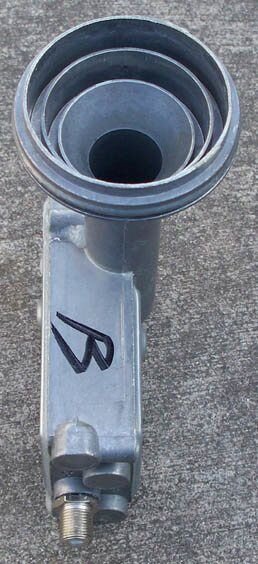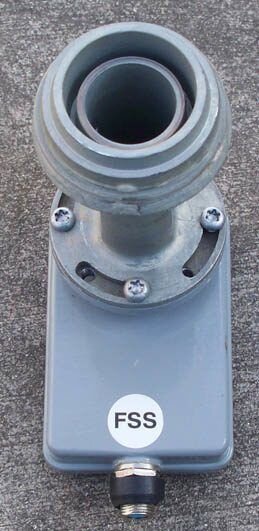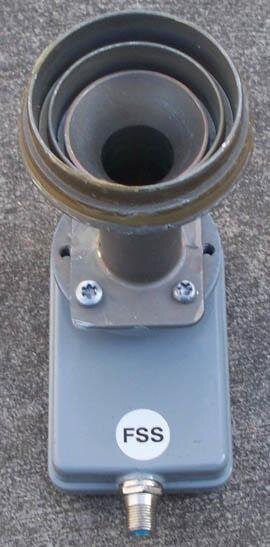I've put up three WaveFrontier T90 toroids over the past months to cover the North American FTA Ku birds. Considering the number of orbital positions involved, the use of bandstacked LNBs makes a lot of sense in terms of limiting the cost and complexity of cabling and switching. However the choices for bandstacked Ku LNBs is very limited. Until recently the only commonly available option was to salvage feeds and LNBs from Dish Network 105W and 121W SuperDishes. Then Sadoun released the KLBS1 LNBF which I evaluated a couple of months ago, here. I've been trying to decide on the final configuration for my toroid LNBs, and decided to have a shootout.
The competitors were:
1. Sadoun KLBS1 LNBF. I strip the plastic case to provide better mounting on the toroid rails. The KLBS1 has LOFs of 10750 (H) and 10100 (V), meaning H is sent from 950-1450 MHz and V is sent from 1600-2100 MHz. This unit has a lot of gain and a high output level.
2. Dish FSS LNB + 105W feed. Of the two stock SuperDish FSS feeds, the 105W version is the easier to work with. The horn mouth is small and the waveguide is set up to handle circular polarization if rotated by 45 degrees. Like all Dish FSS LNBs, the LOFs are 10750 (V) and 13850 (H), meaning V is sent from 950-1450 MHz and H is sent from 2150-1650 MHz (inverted). These LNBs have much less gain than the Sadoun units.
3. Dish FSS LNB + 121W feed. The second SuperDish feed is compromised because it had to work next to a 119W feed. The horn mouth is narrow and tall to accommodate this. The waveguide is also extended to allow physical space for both the 119 and 121 LNBs. Both the 119 and 121 feeds are cast as a single unit. Common practice is to separate these with a hacksaw.
4. Dish FSS LNB + DP feed. Given the striking similarity of the Sadoun and DishPro feeds, I couldn't help but chop a DishPro LNBF down and bolt the remaining feed to a SuperDish LNB. I wanted to see if I could improve on the original SuperDish feed performance, which isn't that inspiring.
All of these are shown in the attached pictures. The mod to couple the DP feed to a SuperDish LNB is pretty much self-explanatory. One of my toroids is centered on 97W, which has a lot of high CNR transponders to use over the H & V ranges. I chose six and for each competitor made quick CNR measurements of each. At the same time I wanted to test the benefit of using amps at the dish. There isn't a lot of cable to my test setup, but there are switches, taps and other paraphernalia in-line that make using the SuperDish LNBs a bit on the ragged edge with its low output level. So each competitor was measured with and without an amp in series. The entire signal path was the same for each test and I made the changeovers as quickly as possible. The same SuperDish LNB was used for the three feeds to prevent having that become a separate variable.
The measured CNRs are listed tabularly and are plotted in the attachments. I also included a table showing the relative performance of each combination with respect to the DP feed + FSS LNB, which overall came out on top. Finally there are a table and plot of the 'benefit' of using an amplifier for each competitor. Not surprisingly the Sadoun unit does much better without an amp. It has a very hot output compared to the Dish FSS LNB. The Dish FSS LNB showed some significant improvements with the amp.
Comparing the best amp configuration for each competitor, my DP + SuperDish LNB concoction was the overall winner. The Sadoun unit was very competitive, beating the winner by small margins on three transponders. However it was behind by larger margins on the other transponders. The stock 105W and 121W feeds finished farther back. Averaging the relative performance compared to the winner for the six transponders I calculated:
1. DP feed + FSS LNB: 0.0 dB (reference)
2. Sadoun KLBS1 LNBF: -0.5 dB
3. 105W feed + FSS LNB: -1.8 dB
4. 121W feed + FSS LNB: -3.3 dB
The above data show the importance of a good feed, as the first and last place finishers used the exact same LNB in the tests. The Sadoun is a readily available unit at a reasonable price and it performs very well. However the modified DishPro feed, which looks almost identical to the Sadoun feed, when coupled to a SuperDish LNB does outperform it. There may be some unit-to-unit variations, but quick pretesting I did with other Sadoun and Dish LNBs showed nearly identical results.
There are other factors other than CNR. I did not evaluate phase noise, nor did I look at LO frequency accuracy/stability. It should be pointed out the results are for a T90 dish; the feed matching to other Ku dishes may be different. The SuperDish parts are largely only available through eBay. The modification is very easy, but it does entail sacrificing a DishPro LNBF and you are left with the SuperDish feeds. For my purposes I plan to combine the top two units. Where I need to achieve 2 degree spacing on the same toroid, alternating the two gives just enough space to squeeze them in. I will have to slice off some small pieces of the two feedhorn mouths to get them to fit, but this is very straightforward.
The competitors were:
1. Sadoun KLBS1 LNBF. I strip the plastic case to provide better mounting on the toroid rails. The KLBS1 has LOFs of 10750 (H) and 10100 (V), meaning H is sent from 950-1450 MHz and V is sent from 1600-2100 MHz. This unit has a lot of gain and a high output level.
2. Dish FSS LNB + 105W feed. Of the two stock SuperDish FSS feeds, the 105W version is the easier to work with. The horn mouth is small and the waveguide is set up to handle circular polarization if rotated by 45 degrees. Like all Dish FSS LNBs, the LOFs are 10750 (V) and 13850 (H), meaning V is sent from 950-1450 MHz and H is sent from 2150-1650 MHz (inverted). These LNBs have much less gain than the Sadoun units.
3. Dish FSS LNB + 121W feed. The second SuperDish feed is compromised because it had to work next to a 119W feed. The horn mouth is narrow and tall to accommodate this. The waveguide is also extended to allow physical space for both the 119 and 121 LNBs. Both the 119 and 121 feeds are cast as a single unit. Common practice is to separate these with a hacksaw.
4. Dish FSS LNB + DP feed. Given the striking similarity of the Sadoun and DishPro feeds, I couldn't help but chop a DishPro LNBF down and bolt the remaining feed to a SuperDish LNB. I wanted to see if I could improve on the original SuperDish feed performance, which isn't that inspiring.
All of these are shown in the attached pictures. The mod to couple the DP feed to a SuperDish LNB is pretty much self-explanatory. One of my toroids is centered on 97W, which has a lot of high CNR transponders to use over the H & V ranges. I chose six and for each competitor made quick CNR measurements of each. At the same time I wanted to test the benefit of using amps at the dish. There isn't a lot of cable to my test setup, but there are switches, taps and other paraphernalia in-line that make using the SuperDish LNBs a bit on the ragged edge with its low output level. So each competitor was measured with and without an amp in series. The entire signal path was the same for each test and I made the changeovers as quickly as possible. The same SuperDish LNB was used for the three feeds to prevent having that become a separate variable.
The measured CNRs are listed tabularly and are plotted in the attachments. I also included a table showing the relative performance of each combination with respect to the DP feed + FSS LNB, which overall came out on top. Finally there are a table and plot of the 'benefit' of using an amplifier for each competitor. Not surprisingly the Sadoun unit does much better without an amp. It has a very hot output compared to the Dish FSS LNB. The Dish FSS LNB showed some significant improvements with the amp.
Comparing the best amp configuration for each competitor, my DP + SuperDish LNB concoction was the overall winner. The Sadoun unit was very competitive, beating the winner by small margins on three transponders. However it was behind by larger margins on the other transponders. The stock 105W and 121W feeds finished farther back. Averaging the relative performance compared to the winner for the six transponders I calculated:
1. DP feed + FSS LNB: 0.0 dB (reference)
2. Sadoun KLBS1 LNBF: -0.5 dB
3. 105W feed + FSS LNB: -1.8 dB
4. 121W feed + FSS LNB: -3.3 dB
The above data show the importance of a good feed, as the first and last place finishers used the exact same LNB in the tests. The Sadoun is a readily available unit at a reasonable price and it performs very well. However the modified DishPro feed, which looks almost identical to the Sadoun feed, when coupled to a SuperDish LNB does outperform it. There may be some unit-to-unit variations, but quick pretesting I did with other Sadoun and Dish LNBs showed nearly identical results.
There are other factors other than CNR. I did not evaluate phase noise, nor did I look at LO frequency accuracy/stability. It should be pointed out the results are for a T90 dish; the feed matching to other Ku dishes may be different. The SuperDish parts are largely only available through eBay. The modification is very easy, but it does entail sacrificing a DishPro LNBF and you are left with the SuperDish feeds. For my purposes I plan to combine the top two units. Where I need to achieve 2 degree spacing on the same toroid, alternating the two gives just enough space to squeeze them in. I will have to slice off some small pieces of the two feedhorn mouths to get them to fit, but this is very straightforward.
Attachments
-
 Naked Sadoun KLBS1 LNBF.jpg37.5 KB · Views: 369
Naked Sadoun KLBS1 LNBF.jpg37.5 KB · Views: 369 -
 SuperDish 105 Feed & LNB.jpg31 KB · Views: 387
SuperDish 105 Feed & LNB.jpg31 KB · Views: 387 -
 SuperDish 121 Feed & LNB.jpg43.8 KB · Views: 408
SuperDish 121 Feed & LNB.jpg43.8 KB · Views: 408 -
 SuperDish LNB + DP Feed.jpg23.6 KB · Views: 402
SuperDish LNB + DP Feed.jpg23.6 KB · Views: 402 -
 CNR Table.png1.8 KB · Views: 345
CNR Table.png1.8 KB · Views: 345 -
CNR vs. TP vs. Config.pdf18.3 KB · Views: 913
-
 CNR Deltas.png1.8 KB · Views: 309
CNR Deltas.png1.8 KB · Views: 309 -
 Amp Improvement Table.png973 bytes · Views: 346
Amp Improvement Table.png973 bytes · Views: 346 -
Amp Effect vs TP vs Config.pdf16.9 KB · Views: 363


